Amelanchier alnifolia
Amelanchier alnifolia, the saskatoon, Pacific serviceberry, western serviceberry, alder-leaf shadbush, dwarf shadbush, chuckley pear, or western juneberry,[2] is a shrub with edible berry-like fruit, native to North America from Alaska across most of western Canada and in the western and north-central United States. Historically, it was also called pigeon berry.[3] It grows from sea level in the north of the range, up to 2,600 m (8,530 ft) elevation in California and 3,400 m (11,200 ft) in the Rocky Mountains,[2][4][5] and is a common shrub in the forest understory.[6]
| Amelanchier alnifolia | |
|---|---|
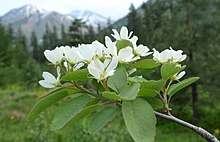 | |
| A. a. var. semiintegrifolia at Icicle Canyon, Chelan County Washington | |
| Scientific classification | |
| Kingdom: | Plantae |
| Clade: | Tracheophytes |
| Clade: | Angiosperms |
| Clade: | Eudicots |
| Clade: | Rosids |
| Order: | Rosales |
| Family: | Rosaceae |
| Genus: | Amelanchier |
| Species: | A. alnifolia |
| Binomial name | |
| Amelanchier alnifolia (Nutt.) Nutt. | |
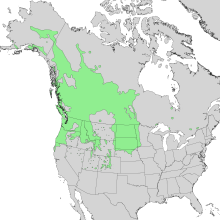 | |
| Natural range of Amelanchier alnifolia | |
| Synonyms[2] | |
| |
Etymology
The name saskatoon derives from the Cree inanimate noun misâskwatômina (misâskwatômin NI sg, saskatoonberry, misâskwatômina NI pl saskatoonberries).[7] The city of Saskatoon, Saskatchewan, is named after this berry.
The species name alnifolia is a feminine adjective. It is a compound of the Latin word for "alder", alnus, and the word for "leaf", folium.
Description
It is a deciduous shrub or small tree that most often grows to 1–8 m (3–26 ft),[5] rarely to 10 m or 33 ft,[8] in height. Its growth form spans from suckering and forming colonies to clumped.[4]
The leaves are oval to nearly circular, 2–5 cm (3⁄4–2 in) long and 1–4.5 cm (1⁄2–1 3⁄4 in) broad, on a 0.5–2 cm (1⁄4–3⁄4 in) leaf stem, margins toothed mostly above the middle.[4] The foliage is browsed by deer and livestock.[9]
As with all species in the genus Amelanchier, the flowers are white, with five quite separate petals. In A. alnifolia, they are about 2–3 cm (3⁄4–1 1⁄4 in) across, and appear on short racemes of three to 20[4] somewhat crowded together, in spring while the new leaves are still expanding.
The fruit is a small purple pome 5–15 mm (3⁄16–19⁄32 in) in diameter, ripening in early summer in the coastal areas and late summer further inland.[4][5] They are eaten by wildlife including birds, squirrels and bears.[9] It is also a larval host to the pale tiger swallowtail, two-tailed swallowtail, and the western tiger swallowtail.[10]
Varieties
Cultivation and uses
Seedlings are planted with 13–20 feet (4.0–6.1 m) between rows and 1.5–3 feet (0.46–0.91 m) between plants. An individual bush may bear fruit 30 or more years.[17]
Saskatoons are adaptable to most soil types with exception of poorly drained or heavy clay soils lacking organic matter. Shallow soils should be avoided, especially if the water table is high or erratic. Winter hardiness is exceptional, but frost can damage blooms as late as May. Large amounts of sunshine are needed for fruit ripening.[17][18]
With a sweet, nutty taste, the fruits have long been eaten by Canada's aboriginal people, fresh or dried. They are well known as an ingredient in pemmican, a preparation of dried meat to which saskatoon berries are added as flavour and preservative. They are used in saskatoon berry pie, jam, wines, cider, beers, and sugar-infused berries similar to dried cranberries used for cereals, trail mix, and snack foods.[19][20][21][18]
In 2004, the British Food Standards Agency suspended saskatoon berries from retail sales[22] pending safety testing; the ban eventually was lifted after pressure from the European Union.
Diseases and pests
A. alnifolia is susceptible to cedar-apple rust, entomosporium leaf spot, fireblight, brown rot, cytospora canker, powdery mildew, and blackleaf.[23] Problem insects include aphids, thrips, mites, bud moths, Saskatoon sawflies, and pear slug sawflies.[23]
Nutrients
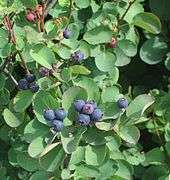
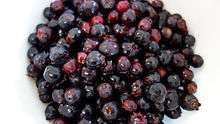
| Nutrients in raw saskatoon berries[19] | ||
| Nutrient | Value per 100 g | % Daily Value |
|---|---|---|
| Energy | 85 kcal | |
| Total dietary fiber | 5.9 g | 20% |
| Sugars, total | 11.4 g | 8% |
| Calcium | 42 mg | 4% |
| Magnesium | 24 mg | 6% |
| Iron | 1 mg | 12% |
| Manganese | 1.4 mg | 70% |
| Potassium | 162 mg | 3% |
| Sodium | 0.5 mg | 0% |
| Vitamin C | 3.6 mg | 4% |
| Vitamin A | 11 IU | 1% |
| Vitamin E | 1.1 mg | 7% |
| Folate | 4.6 µg | 1% |
| Riboflavin | 3.5 mg | > 100% |
| Panthothenic acid | 0.3 mg | 6% |
| Pyridoxine | 0.03 mg | 2% |
| Biotin | 20 µg | 67% |
Saskatoon berries contain significant amounts of total dietary fiber, riboflavin and biotin, and the dietary minerals, iron and manganese, a nutrient profile similar to the content of blueberries.[19]
Polyphenols
Also similar in composition to blueberries,[19] saskatoons have total polyphenol content of 452 mg per 100 g (average of 'Smoky' and 'Northline' cultivars), flavonols (61 mg) and anthocyanins (178 mg),[19] although others have found the phenolic values to be either lower in the 'Smoky' cultivar[24] or higher.[25] Quercetin, cyanidin, delphinidin, pelargonidin, petunidin, peonidin, and malvidin were present in saskatoon berries.[19][26]
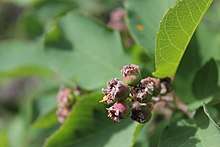
References
![]()
- Botanic Gardens Conservation International (BGCI). & IUCN SSC Global Tree Specialist Group. (2018). "Amelanchier alnifolia". The IUCN Red List of Threatened Species. IUCN. 208. e.T135957919A135957921. doi:10.2305/IUCN.UK.2018-2.RLTS.T135957919A135957921.en.
- "Amelanchier alnifolia". Germplasm Resources Information Network (GRIN). Agricultural Research Service (ARS), United States Department of Agriculture (USDA). Retrieved 14 December 2017.
- Schorger, A.W. 1955. The Passenger Pigeon; its natural history and extinction. The University of Wisconsin Press, Madison.
- "Amelanchier alnifolia". Plants of British Columbia. Archived from the original on 2012-02-08. Retrieved 2007-10-19.
- "Amelanchier alnifolia". Jepson Flora.
- Dyrness, C. T.; Acker, S. A. (2010). "Ecology of Common Understory Plants in Northwestern Oregon and Southwestern Washington Forests" (PDF). H.J. Andrews Experimental Forest, Oregon State University. Archived from the original (PDF) on 1 March 2012. Retrieved 23 January 2014.
- "saskatoon". Oxford English Dictionary (3rd ed.). Oxford University Press. September 2005. (Subscription or UK public library membership required.)
- Jacobson, Arthur Lee (1996). North American Landscape Trees. Berkeley, CA USA: Ten Speed Press. p. 74. ISBN 0-89815-813-3.
Records: 42' x 3'3" x 43', Beacon Rock State Park, WA (1993); 27' x 3'9" x 22', Douglas County, OR (1975)
- Little, Elbert L. (1994) [1980]. The Audubon Society Field Guide to North American Trees: Western Region (Chanticleer Press ed.). Knopf. pp. 443–44. ISBN 0394507614.
- The Xerces Society (2016), Gardening for Butterflies: How You Can Attract and Protect Beautiful, Beneficial Insects, Timber Press.
- University of Maine: Amelanchier list of taxa
- "Amelanchier alnifolia var. alnifolia". University of Maine.
- "Amelanchier alnifolia var. pumila". Jepson Flora.
- "Amelanchier alnifolia var. pumila". University of Maine. Archived from the original on 2012-03-31. Retrieved 2011-09-18.
- "Amelanchier alnifolia var. semiintegrifolia". Jepson Flora.
- "Amelanchier alnifolia var. semiintegrifolia". University of Maine.
- "Introduction to Saskatoons". Archived from the original on 2008-12-12. Retrieved 2008-01-06.
- St-Pierre, R. G. "Growing Saskatoons - A Manual For Orchardists". Archived from the original on 2008-03-17. Retrieved 2006-05-28.
- Mazza, G. (2005). "Compositional and Functional Properties of Saskatoon Berry and Blueberry". International Journal of Fruit Science. 5 (3): 101–120. doi:10.1300/J492v05n03_10. ISSN 1553-8362.
- Mazza, G; Davidson, CG (1993). "Saskatoon berry: A fruit crop for the prairies". In Janick, J.; Simon, J.E. (eds.). New crops. New York: Wiley. pp. 516–519.
- "Saskatoon Berries". Government of Manitoba - Ministry of Agriculture. Archived from the original on 2013-10-02. Retrieved 2017-08-24.
- "Britain plucks saskatoon berries from store shelves". CBC News. 2004-07-07. Retrieved 2015-07-22.
- "Juneberries – Amelanchier alnifolia". Carrington REC. Retrieved 13 May 2017.
- Ozga; Saeed, A; Wismer, W; Reinecke, DM (2007). "Characterization of cyanidin- and quercetin-derived flavonoids and other phenolics in mature saskatoon fruits (Amelanchier alnifolia Nutt.)". Journal of Agricultural and Food Chemistry. 55 (25): 10414–24. doi:10.1021/jf072949b. PMID 17994693.
- Hosseinian; Beta, T (2007). "Saskatoon and wild blueberries have higher anthocyanin contents than other Manitoba berries". Journal of Agricultural and Food Chemistry. 55 (26): 10832–8. doi:10.1021/jf072529m. PMID 18052240.
- Bakowska-barczak; Marianchuk, M; Kolodziejczyk, P (2007). "Survey of bioactive components in Western Canadian berries". Canadian Journal of Physiology and Pharmacology. 85 (11): 1139–52. doi:10.1139/y07-102. PMID 18066116.
